人教版七年级英语下册Unit3教案
- 格式:doc
- 大小:104.00 KB
- 文档页数:19
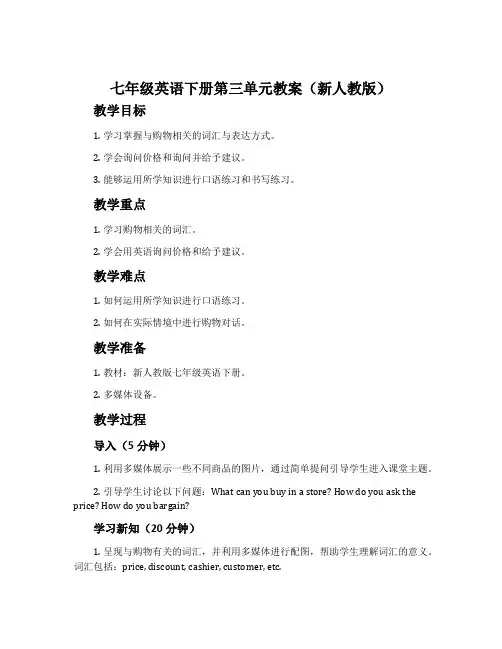
七年级英语下册第三单元教案(新人教版)教学目标1.学习掌握与购物相关的词汇与表达方式。
2.学会询问价格和询问并给予建议。
3.能够运用所学知识进行口语练习和书写练习。
教学重点1.学习购物相关的词汇。
2.学会用英语询问价格和给予建议。
教学难点1.如何运用所学知识进行口语练习。
2.如何在实际情境中进行购物对话。
教学准备1.教材:新人教版七年级英语下册。
2.多媒体设备。
教学过程导入(5分钟)1.利用多媒体展示一些不同商品的图片,通过简单提问引导学生进入课堂主题。
2.引导学生讨论以下问题:What can you buy in a store? How do you ask the price? How do you bargain?学习新知(20分钟)1.呈现与购物有关的词汇,并利用多媒体进行配图,帮助学生理解词汇的意义。
词汇包括:price, discount, cashier, customer, etc.2.向学生介绍并练习询问价格的句型,例如:How much is it? 或者How much does it cost?3.向学生介绍并练习给予建议的句型,例如:I think you should buy… 或者Wh y don’t you try…?4.利用多媒体进行示范,让学生模仿老师的语音、语调和表达方式。
情境对话(15分钟)1.学生分成小组,每组两人,一人扮演顾客,一人扮演售货员。
2.学生根据所给的商品图片进行情境对话,练习询问价格和给予建议。
3.在对话的过程中,教师可以巡视并指导学生,纠正他们的语音和语法错误。
讨论与练习(15分钟)1.教师提出一些与购物相关的问题,例如:What’s your favorite store? How often do you go shopping? Do you prefer shopping online or in stores?2.学生利用所学句型进行回答,并互相组织小组讨论。
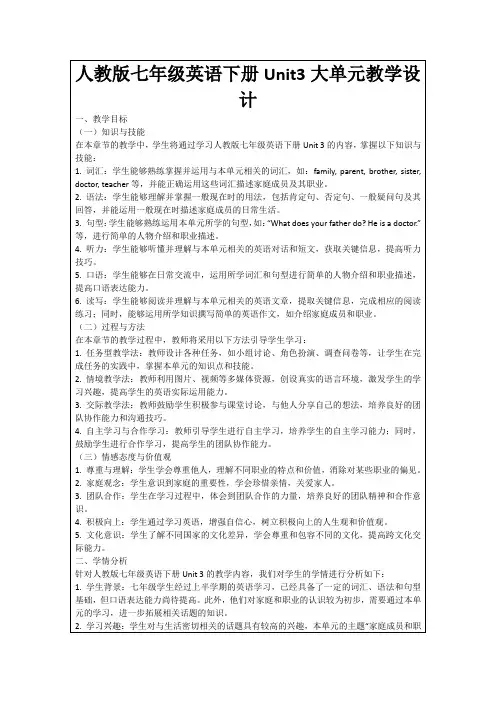
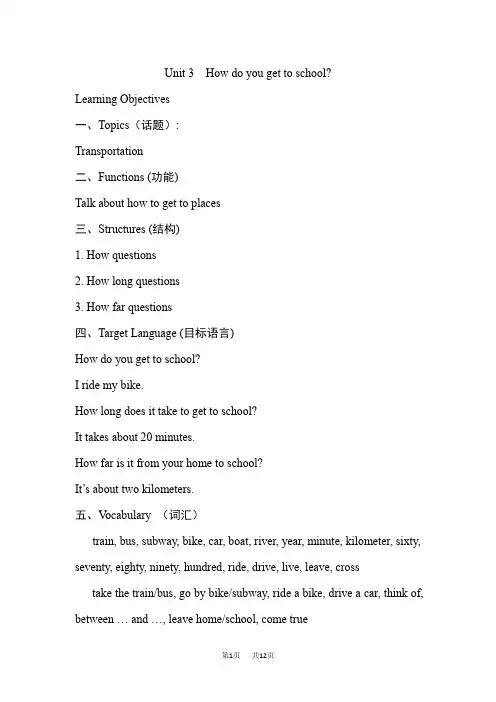
Unit 3 How do you get to school?Learning Objectives一、Topics(话题):Transportation二、Functions (功能)Talk about how to get to places三、Structures (结构)1. How questions2. How long questions3. How far questions四、Target Language (目标语言)How do you get to school?I ride my bike.How long does it take to get to school?It takes about 20 minutes.How far is it from your home to school?It’s about two kilometers.五、V ocabulary (词汇)train, bus, subway, bike, car, boat, river, year, minute, kilometer, sixty, seventy, eighty, ninety, hundred, ride, drive, live, leave, cross take the train/bus, go by bike/subway, ride a bike, drive a car, think of, between … and …, leave home/school, come true六、Skills (技能)Listening for key informationScanning in reading七、Recycling (复习巩固)Numbers 1–30I usually …It is easy to …Thanks for …八、教材分析本单元以How do you get to school?为中心话题,主要运用How long/How far 询问“去某地的交通方式、时间、距离”,简单描述路线。
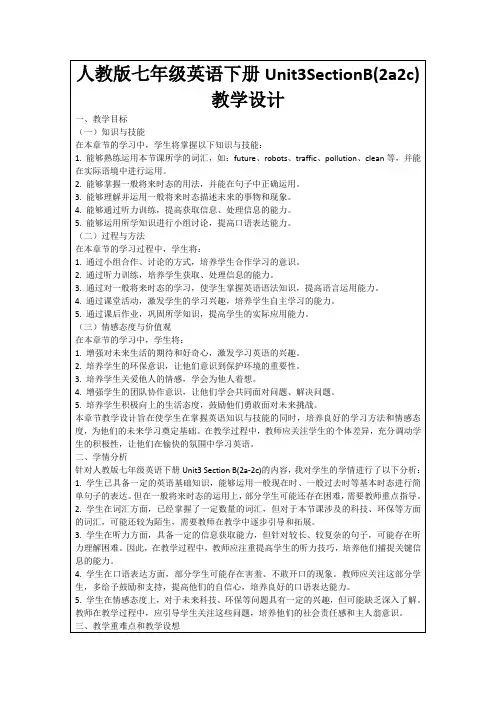
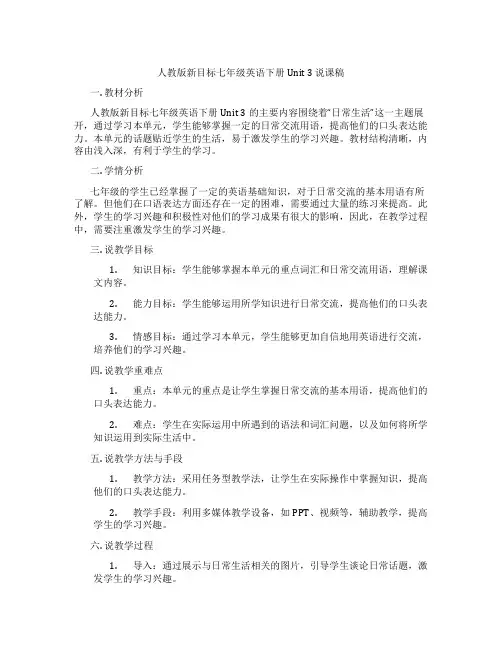
人教版新目标七年级英语下册 Unit 3 说课稿一. 教材分析人教版新目标七年级英语下册Unit 3的主要内容围绕着“日常生活”这一主题展开,通过学习本单元,学生能够掌握一定的日常交流用语,提高他们的口头表达能力。
本单元的话题贴近学生的生活,易于激发学生的学习兴趣。
教材结构清晰,内容由浅入深,有利于学生的学习。
二. 学情分析七年级的学生已经掌握了一定的英语基础知识,对于日常交流的基本用语有所了解。
但他们在口语表达方面还存在一定的困难,需要通过大量的练习来提高。
此外,学生的学习兴趣和积极性对他们的学习成果有很大的影响,因此,在教学过程中,需要注重激发学生的学习兴趣。
三. 说教学目标1.知识目标:学生能够掌握本单元的重点词汇和日常交流用语,理解课文内容。
2.能力目标:学生能够运用所学知识进行日常交流,提高他们的口头表达能力。
3.情感目标:通过学习本单元,学生能够更加自信地用英语进行交流,培养他们的学习兴趣。
四. 说教学重难点1.重点:本单元的重点是让学生掌握日常交流的基本用语,提高他们的口头表达能力。
2.难点:学生在实际运用中所遇到的语法和词汇问题,以及如何将所学知识运用到实际生活中。
五. 说教学方法与手段1.教学方法:采用任务型教学法,让学生在实际操作中掌握知识,提高他们的口头表达能力。
2.教学手段:利用多媒体教学设备,如PPT、视频等,辅助教学,提高学生的学习兴趣。
六. 说教学过程1.导入:通过展示与日常生活相关的图片,引导学生谈论日常话题,激发学生的学习兴趣。
2.新课呈现:讲解本节课的重点词汇和日常交流用语,让学生进行实际操作,如角色扮演等。
3.课堂练习:设计一些日常交流的场景,让学生进行实际运用,巩固所学知识。
4.课堂小结:对本节课的内容进行总结,让学生明确学习目标。
5.课后作业:布置一些与日常生活相关的任务,让学生课后进行练习,提高他们的口头表达能力。
七. 说板书设计板书设计要清晰、简洁,能够突出本节课的重点内容。
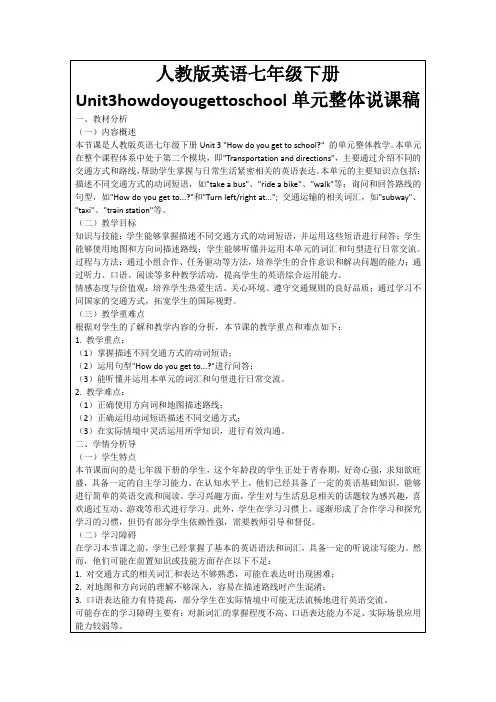
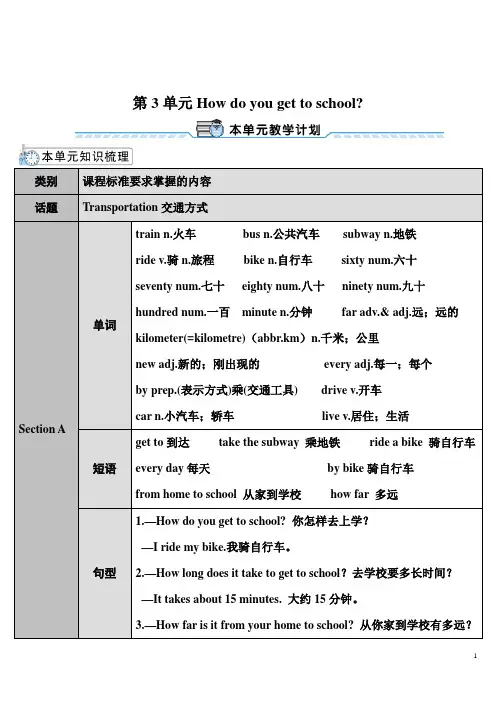
第3单元How do you get to school?类别课程标准要求掌握的内容话题Transportation交通方式Section A 单词train n.火车bus n.公共汽车subway n.地铁ride v.骑n.旅程bike n.自行车sixty num.六十seventy num.七十eighty num.八十ninety num.九十hundred num.一百minute n.分钟far adv.& adj.远;远的kilometer(=kilometre)(abbr.km)n.千米;公里new adj.新的;刚出现的every adj.每一;每个by prep.(表示方式)乘(交通工具) drive v.开车car n.小汽车;轿车live v.居住;生活短语get to到达take the subway 乘地铁ride a bike 骑自行车every day每天by bike骑自行车from home to school 从家到学校how far 多远句型1.—How do you get to school? 你怎样去上学?—I ride my bike.我骑自行车。
2.—How long does it take to get to school?去学校要多长时间?—It takes about 15 minutes. 大约15分钟。
3.—How far is it from your home to school? 从你家到学校有多远?语法how引导的一般现在时的特殊疑问句写作介绍自己或他人的出行方式知识目标掌握how引导的特殊疑问句。
能力目标能掌握有关乘坐交通工具的对话和谈论各种交通工具的文章,并能熟练运用“介词by+交通工具”和“take + a/an/the+交通工具”等短语,写短文。
情感目标了解现在人们的出行方式与以前发生了哪些变化;培养自己的时间观念,养成良好的守时习惯。

人教版七年级英语下册Unit 3教案Unit 3: How Do You Get to School?n A (1a-2d)Objectives:nguage Knowledge Objectives:To master the following vocabulary: train。
bus。
subway。
ride。
bike。
sixty。
XXX。
eighty。
y。
hundred。
far。
minute。
kilometer。
new。
every。
every day.To master the following sentence structures:How do you get to school?" - "I ride my bike." - "She takes the subway."How does Mary get to school?"To talk about how to get to places。
using phrases such as "take the bus/subway/train/taxi"。
"ride a bike"。
and "walk".XXX how to use "how" to ask about n methods。
as well as "how far" and "how long".XXX.2.Attitude and Value Objectives:To help students XXX-life ns。
not just for English class or exams.To learn about the different XXX methods and rules in different countries.XXX.XXX students to follow traffic laws and be polite。
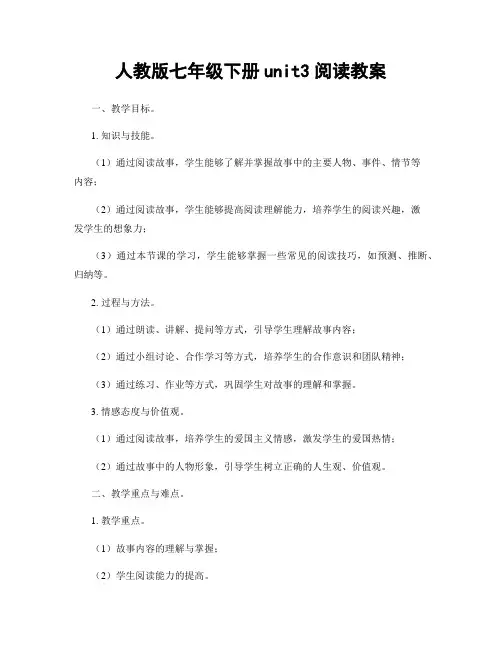
人教版七年级下册unit3阅读教案一、教学目标。
1. 知识与技能。
(1)通过阅读故事,学生能够了解并掌握故事中的主要人物、事件、情节等内容;(2)通过阅读故事,学生能够提高阅读理解能力,培养学生的阅读兴趣,激发学生的想象力;(3)通过本节课的学习,学生能够掌握一些常见的阅读技巧,如预测、推断、归纳等。
2. 过程与方法。
(1)通过朗读、讲解、提问等方式,引导学生理解故事内容;(2)通过小组讨论、合作学习等方式,培养学生的合作意识和团队精神;(3)通过练习、作业等方式,巩固学生对故事的理解和掌握。
3. 情感态度与价值观。
(1)通过阅读故事,培养学生的爱国主义情感,激发学生的爱国热情;(2)通过故事中的人物形象,引导学生树立正确的人生观、价值观。
二、教学重点与难点。
1. 教学重点。
(1)故事内容的理解与掌握;(2)学生阅读能力的提高。
2. 教学难点。
(1)培养学生的阅读兴趣;(2)引导学生进行深层次的阅读理解。
三、教学过程。
1. 导入新课。
通过谈论一些与故事有关的话题,引起学生的兴趣,如“你喜欢听故事吗?为什么?”、“你最喜欢的故事是什么?为什么?”等。
2. 阅读故事。
(1)教师朗读故事,学生跟读;(2)教师讲解故事中的生词、短语等;(3)学生分组讨论故事中的主要人物、事件、情节等内容;(4)学生展示小组讨论成果,进行互动交流。
3. 操作练习。
(1)学生个人完成故事相关的练习题,如选择题、判断题等;(2)学生交流答案,订正错误。
4. 拓展延伸。
(1)教师提出一些与故事相关的问题,引导学生进行深层次的思考和讨论;(2)学生进行小组合作,展示他们对故事的理解和想法;(3)学生进行个人总结,写下对故事的感想。
5. 作业布置。
布置阅读相关的作业,如写一篇关于故事的读后感,或者选择一段故事进行朗读等。
四、教学反思。
本节课通过故事的阅读,引发学生的阅读兴趣,培养学生的阅读能力,同时也培养了学生的合作意识和团队精神。
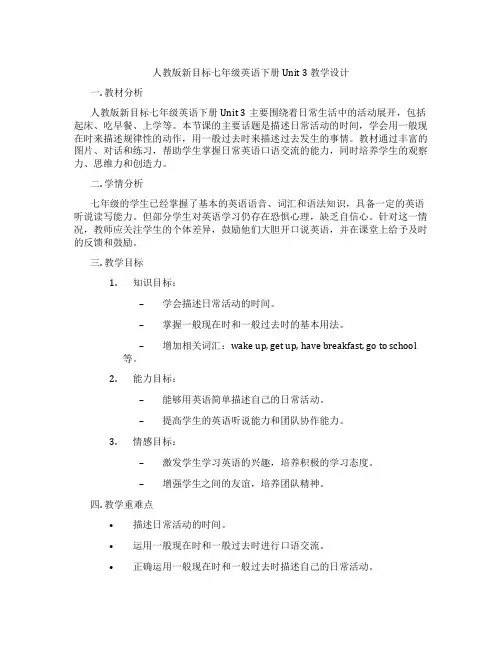
人教版新目标七年级英语下册 Unit 3 教学设计一. 教材分析人教版新目标七年级英语下册Unit 3主要围绕着日常生活中的活动展开,包括起床、吃早餐、上学等。
本节课的主要话题是描述日常活动的时间,学会用一般现在时来描述规律性的动作,用一般过去时来描述过去发生的事情。
教材通过丰富的图片、对话和练习,帮助学生掌握日常英语口语交流的能力,同时培养学生的观察力、思维力和创造力。
二. 学情分析七年级的学生已经掌握了基本的英语语音、词汇和语法知识,具备一定的英语听说读写能力。
但部分学生对英语学习仍存在恐惧心理,缺乏自信心。
针对这一情况,教师应关注学生的个体差异,鼓励他们大胆开口说英语,并在课堂上给予及时的反馈和鼓励。
三. 教学目标1.知识目标:–学会描述日常活动的时间。
–掌握一般现在时和一般过去时的基本用法。
–增加相关词汇:wake up, get up, have breakfast, go to school 等。
2.能力目标:–能够用英语简单描述自己的日常活动。
–提高学生的英语听说能力和团队协作能力。
3.情感目标:–激发学生学习英语的兴趣,培养积极的学习态度。
–增强学生之间的友谊,培养团队精神。
四. 教学重难点•描述日常活动的时间。
•运用一般现在时和一般过去时进行口语交流。
•正确运用一般现在时和一般过去时描述自己的日常活动。
•学会在适当的情境下使用一般现在时和一般过去时。
五. 教学方法1.情境教学法:通过设定生活情境,让学生在实际语境中学习、运用英语。
2.任务型教学法:引导学生参与各种小组活动,提高学生的团队协作能力和口语表达能力。
3.激励评价法:及时给予学生反馈,关注学生的点滴进步,激发学生的学习兴趣。
六. 教学准备1.教学素材:教材、多媒体课件、录音机、磁带、相关图片等。
2.教学工具:黑板、粉笔、投影仪等。
七. 教学过程1.导入(5分钟)–教师与学生用英语进行自由谈话,引导学生谈论日常活动。
–提问:What time do you get up? What do you have for breakfast? 让学生用英语回答。

人教版七年级下册英语Unit 3 教学设计一. 教材分析人教版七年级下册英语Unit 3以“日常活动”为主题,通过介绍日常生活中的活动,让学生学会描述自己的日常安排和兴趣爱好。
本单元的核心词汇有play, watch, read, write, listen to, cook等,核心句型为“What do you do on…? I usually…”和“Do you like…? Yes, I do./ No, I don’t.”。
本单元旨在培养学生用英语进行简单交流的能力,提高他们的语言运用能力。
二. 学情分析七年级的学生已经掌握了基本的英语语法和一定数量的词汇,具备了一定的听说读写能力。
但部分学生在语言运用方面还存在一定的困难,特别是在口语表达和听力理解方面。
因此,在教学过程中,教师需要关注学生的个体差异,调动他们的学习积极性,引导他们主动参与课堂活动。
三. 教学目标1.知识目标:学生能够掌握本单元的核心词汇和句型,正确运用“Whatdo you do on…? I usually…”和“Do you like…? Yes, I do./ No, I don’t.”进行日常交流。
2.能力目标:学生能够在真实情境中运用英语描述自己的日常活动和兴趣爱好,提高他们的语言运用能力。
3.情感目标:培养学生对英语学习的兴趣,增强他们的自信心,使他们更加积极主动地参与课堂活动。
四. 教学重难点1.重点:学生能够熟练掌握并运用本单元的核心词汇和句型进行日常交流。
2.难点:学生能够在真实情境中运用英语描述自己的日常活动和兴趣爱好。
五. 教学方法1.任务型教学法:通过设计各种真实的任务,让学生在完成任务的过程中运用英语,提高他们的语言运用能力。
2.情境教学法:创设各种日常活动的情境,让学生在真实的情境中学习英语,增强他们的学习兴趣。
3.小组合作学习:学生进行小组讨论和合作,培养他们的团队精神和沟通能力。
六. 教学准备1.教材:人教版七年级下册英语教材。
七年级英语下册教学设计Unit 3 How do you get to school?Section A 1a—2e一、教材分析1. 掌握以下词汇:1) 数字类:forty, fifty, sixty, seventy, eighty, ninety, hundred2) 交通工具类:subway, train, bicycle, take, by[2.重要短语和句型:1)短语:take the subway, take the train, take the bus, by + 交通工具(名词单数)ride my bike, walk to school, one hundred and five,from…to…, the bus ride, every day2)句型:A: How do you get to school? (交通方式)B: I usually take the bus.A: How long does it take? (花费时间)B: It takes about 25 minutes by bus.A: How far is it from…to…?(询问距离)[来B: It’s about 10 kilometers.The bus ride takes about twenty minutes..“take the + 某种交通工具” ;“by + 交通工具(名词单数)” ;“时间表示”; “It takes sb. some time to do sth.”How far is it from… to…?(询问距离)二、【教学过程】表示”“It takes sb. some time to do sth.Role-play the conversation.目的:巩固和运用先前输入的目标语言结构;提供完整的对话和真实的语境,供学生在模仿的基础上生成新的口语表达。
第三课时Section B(1)教案Ⅰ.根据句意及首字母提示完成单词。
1.Look!There are some boats on the r________.2.Who is the boy b_________ your mother and fat her?3.—How old is your sister?—She’s twelve y_________ old.4.My mom always says “Have a good d________!” before I go to bed.5.When the girl sees the dog, she’s always a__________.Ⅱ.用括号中所给单词的适当形式填空。
6.I don’t know where she__________ (live).7.How do you usually get to your____________ (grandparent)home?8.They always stop__________(talk)when the teacher comes into the classroom.9.It takes me an hour ___________(finish)my homework every day.10.She thinks of____________ (visit)the Great Wall.Ⅲ.单项选择。
( )11.How long does __________ take to get to school?A.youB.heC.itD./( )12.Does Bob often __________ school early?A.arriveB.g et toC.arrive inD.get( )13.— ________do you _________ the football game?—It is wonderful.A.What;think ofB.How;think ofC.What;likeD.How;think( )14.Bill wants t o know_________ .A.where does she liveB.how old are youC.where she livesD.how long does it take to get to school()15.Lily often goes to school ___________ her father’s car.A.byB.onC.withD.inⅣ.按要求完成句子。
人教版新目标七年级英语下册 Unit 3教学设计一. 教材分析人教版新目标七年级英语下册Unit 3的主题是“Where’s my school bag?”,主要学习如何询问和描述物品的位置。
本单元包括问候与介绍、询问物品位置、描述物品位置、电话交流等情景,旨在培养学生的日常交际能力。
教材内容丰富,贴近生活,有利于激发学生的学习兴趣。
二. 学情分析七年级的学生已经掌握了基本的英语语法和词汇,具备一定的听说读写能力。
但是,学生在实际运用英语进行交流时,还存在着一定的困难。
因此,在教学过程中,需要注重培养学生的实际交际能力,提高他们的语言运用水平。
三. 教学目标1.知识目标:学生能够掌握表示位置的词汇和句型,如“on, under, nextto, between”等,并能够用英语描述物品的位置。
2.能力目标:学生能够在真实情境中运用所学知识进行交流,提高日常交际能力。
3.情感目标:学生能够积极参与课堂活动,增强学习英语的兴趣。
四. 教学重难点1.重点:学生能够掌握表示位置的词汇和句型,并能够用英语描述物品的位置。
2.难点:学生能够在真实情境中灵活运用所学知识进行交流。
五. 教学方法1.任务型教学法:通过设置各种真实的任务,让学生在完成任务的过程中运用所学知识,提高实际交际能力。
2.情境教学法:创设各种生活情境,让学生在情境中感知和运用语言。
3.互动式教学法:鼓励学生积极参与课堂活动,进行师生互动、生生互动。
六. 教学准备1.准备教材、教学课件和相关教具。
2.设计各种真实的任务和情境。
3.准备一些与本节课主题相关的图片、视频等资料。
七. 教学过程1.导入(5分钟)利用图片或视频引入主题,激发学生的学习兴趣。
教师可以用一些简单的问题引导学生进行思考,如“你们在生活中是怎样描述物品位置的?”等。
2.呈现(10分钟)教师通过展示图片或实物,引导学生学习表示位置的词汇和句型,如“on, under, next to, between”等。
Unit 3 How do you get to school?Section A (1a-2d)一、教学目标:1. 语言知识目标:1) 能掌握以下单词:train, bus, subway, ride, bike, sixty, seventy, eighty, ninety, hundred, far, minute, kilometer, new, every, every day2) 能掌握以下句型:①—How do you get to school? —I ride my bike.②—How does Mary get to school? —She takes the subway.2. Talk about how to get to places (谈论出行方式)take the bus /subway /train /taxi , ride a bike /walk .3. how引导的特殊疑问句,表示乘坐何种交通工具的方式。
how far, how long 引导的特殊疑问句。
4. 复习基数词及时间的表示方法。
2. 情感态度价值观目标:让学生感受到他们学习英语是为了在现实生活中进行交流,而不单纯是为了英语课和应付考试而学习,了解东西方国家出行方式的不同,以及不同的交通规则,教育学生注意交通安全, 加深对交通知识的了解。
倡导自觉遵守交通法规及礼貌,构建和谐的人际关系。
了解交通的发展,培养创新精神。
二、教学重难点1. 教学重点:1) how /how far /how long 引导的特殊疑问句.2) 乘坐交通工具的表示方法.3) It takes / sb some time to do sth .2. 教学难点:—How do you get to school? —I take the …/ride …/ walk…—How does Mary get to school? —She takes the subway.—How long does it take? —It takes forty minutes.1。
Unit 3 How do you get to school?Section A (1a-2d)一、教学目标:1. 语言知识目标:1) 能掌握以下单词:train, bus, subway, ride, bike, sixty, seventy, eighty, ninety, hundred, far, minute, kilometer, new, every, every day2) 能掌握以下句型:①—How do you get to school? —I ride my bike.②—How does Mary get to school? —She takes the subway.2. Talk about how to get to places (谈论出行方式)take the bus /subway /train /taxi , ride a bike /walk .3. how引导的特殊疑问句,表示乘坐何种交通工具的方式。
how far, how long 引导的特殊疑问句。
4. 复习基数词及时间的表示方法。
2. 情感态度价值观目标:让学生感受到他们学习英语是为了在现实生活中进行交流,而不单纯是为了英语课和应付考试而学习,了解东西方出行方式的不同,以及不同的交通规则,教育学生注意交通安全, 加深对交通知识的了解。
倡导自觉遵守交通法规及礼貌,构建和谐的人际关系。
了解交通的发展,培养创新精神。
二、教学重难点1. 教学重点:1) how /how far /how long 引导的特殊疑问句.2) 乘坐交通工具的表示方法.3) It takes / sb some time to do sth .2. 教学难点:—How do you get to school? —I take the …/ride …/ walk…—How does Mary get to school? —She takes the subway.—How long does it take? —It takes forty minutes.—How far is it from… to…—It's… kilometers.三、教学过程Ⅰ. Warming-up and Lead in学生和老师进行简单的问候Ss : Good morning , teacher.T: Good morning , classT: Look at the picture. What can you see? Do you like your school? I usually get to school by bike, but sometimes on foot . How do you get to school?Ss 按实际情况作答S1: I ride my bike.S2: I go by bus.S3: ………T: Very good. You’re clever. Let’s learn Unit 4 Section A. 之后板书:“Unit 4 How do you get to school?”Ⅱ. Presentation1. T: If you are here, but your school is in Shanghai. How do you get to school? Ss: I take the bus /plane/ boat / ship / car / taxiI ride a bike / motorbikeT: Do you know any other way?2. Teacher shows pictures on the big screen .归纳出行方式和常用短语.Ask some questions about how you get to…?(让学生积极主动的思考想象总结,多媒体增加趣味性,加强直观性,效果事半功倍)3. Show a picture about Part 1, on the screen.Point at girls or boys in the picture.Ask students to answer and write in the blanks.S1 : How does he / she go to school?S2 : He / She ……Ⅲ. 1aT: Look at the picture on your book. Match the words with the picture.(学生们完成1a的学习任务,然后校对答案)Ⅳ. Listening1. Make sure the Ss know what to do. Give them an example orally if possible.2. Read the names in the box.3. Play the tape and check the answers.Ⅴ. Pair workAsk two students to read the dialogue in the speech bubbles to the class. Then ask students to work in pairs. Ask and answer how students get to school in the picture.Finally ask some pairs of students to present their conversations to the class.Ⅵ. Listening1. Revise the numbers, first, zero~nine, next, ten~nineteen, then, twenty, thirty,forty…finally, twenty-one, twenty-two…Teach the new word "hundred".2. Play the tape for the students to finish 2a. Then play again and check the answersⅦ. PresentationShow a picture on the TV and explain these are your home and school.Teach: home----school How long 10 minutes How far two kilometers Then make up a dialogue to practice.A: How do you get to school?B: I usually take the bus.A: How far is it from your home to school?B: It's about two kilometers.A: How long does it take?B: It takes 30 minutes by busⅧ. Listening1. Tell Ss the following recording is about how Tom and Jane go to school.2. First, listen to the recording fill in the first column.3. Then, play the recording for the Ss again. Ss listen and complete the rest ofthe chart.4. Check the answers.Ⅸ. Role-play1. Read the dialogue and find the answer to these questions:①How does Jane get to school?②How far is it from home to school?③How long does it take to get to school from her home?2. Ss read the conversations and then find the answers to the questions.3. Check the answers with the class.4. Play the recording for the Ss to listen and repeat.5. Ss read the conversation then role-play the conversation.6. Let some pairs act out the conversation.Homework1. Remember the new words and expressions in this period.2. Role-play the conversation after class.板书设计:Section A (Grammar Focus-3c)一、教学目标:1. 语言知识目标:1) 继续练习谈论出行方式take the bus /subway /train /taxi, ride a bike /walk .2)用不同方式练习how引导的特殊疑问句,表示乘坐何种交通工具的方式。
how far, how long 引导的特殊疑问句。
3)复习基数词及时间的表示方法。
2. 情感态度价值观目标:了解东西方出行方式的不同,以及不同的交通规则,教育学生注意交通安全, 加深对交通知识的了解。
倡导自觉遵守交通法规及礼貌,构建和谐的人际关系。
了解交通的发展,培养创新精神。
二、教学重难点1. 教学重点:1) how /how far /how long 引导的特殊疑问句.2) 乘坐交通工具的表示方法.3) It takes sb some time to do sth .2. 教学难点:—How do you get to school? —I take the …/ride …/ walk…—How does Mary get to school? —She takes the subway.—How long does it take? —It takes forty minutes.—How far is it from… to…—It's… kilometers.三、教学过程Ⅰ. Warming- up and revision1. Greet the Ss as usual. Then check the homework.2. Go over the conversation in 2e.Ⅱ. Grammar Focus.1. 学生阅读Grammar Focus中的句子,然后做填空练习。